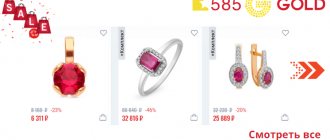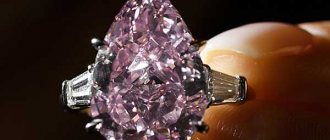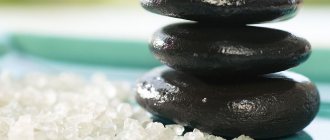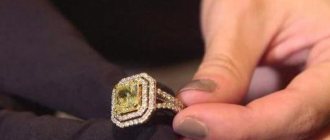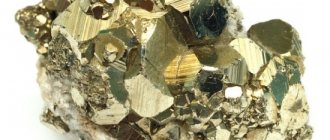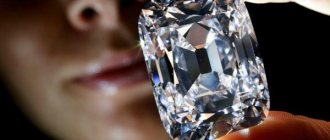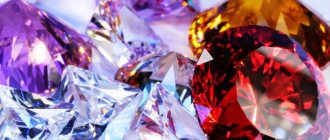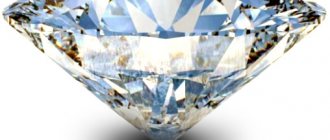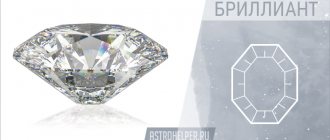- Home page
Unlike a diamond that plays with its facets, a natural diamond does not look as presentable. The jeweler receives a nondescript-looking sample with an irregular shape for processing. The mineral is dull, its surface is covered with a kind of “crust”, riddled with cracks. But even in this state, the diamond is already able to reflect light and play with its edges. The jeweler’s task is to cut the stone so that its individual features in the form of voids and cracks become its additional advantages. A diamond in its natural form will be of interest to collectors and people who want to receive an exclusively cut diamond. For an ordinary person, it is possible to purchase a diamond when traveling on “diamond tours”, where stones are purchased directly at mining sites. In order to avoid becoming a victim of deception or to correctly evaluate a specimen that has fallen into your hands, it is worth understanding the signs of a genuine diamond.
White sapphire
In mineralogy, only the blue variety of the mineral is called sapphire; all the others, with the exception of ruby, are called corundum. White sapphire is a colorless, pure form of aluminum oxide and does not contain the oxides of other metals that color corundums in various shades.
The white variety of sapphire is used as a diamond imitation, or rather, a reasonable alternative to an expensive diamond. This very diamond-like stone is second only to diamond in hardness - 9 on the Mohs scale. The stone is almost impossible to damage. Unless, of course, you deliberately scratch it with industrial diamond or corundum.
Short story
The first reports about the production of artificially grown diamonds began to reach the world scientific community at the end of the 19th century, but most of them were false.
Ring with artificial diamond
The resulting crystals, unlike natural ones, had a different chemical composition, did not consist of carbon and did not have the properties of diamond, which primarily include:
- the maximum hardness among all known substances is 10 according to Mohs;
- high thermal conductivity;
- high light dispersion;
- low thermal expansion;
- chemical inertness;
- low friction coefficient;
- high electrical resistance.
Simply put, diamond is the world’s hardest dielectric (a substance that does not allow current to pass through), which heats up very quickly, but practically does not expand when heated.
Natural diamond is an inert substance that does not react with alkalis and acids under normal conditions.
At high temperatures, diamond flares up and burns, turning into graphite soot.
Ironically, diamond is made of carbon, the same substance as graphite, which has a Mohs hardness of 1. The properties of diamond are due to a different atomic structure.
For the first time, real diamonds were produced in Sweden in 1953. The diamond synthesis technologies invented then were based on reproducing the natural conditions for the formation of this mineral. It was necessary to recreate high pressure and temperature - 60 thousand atmospheres and 1.5 thousand degrees Celsius - to obtain the ideal diamond structure.
Production technologies
Currently, true man-made diamonds, which are cut into diamonds, are grown using two main methods. They are called HPHT and CVD methods, respectively.
The first name is an English abbreviation, translated as “high pressure, high temperature.” This method can be used to obtain crystals of regular cubic or dodecahedral shape.
The essence of the method: a workpiece made of graphite and a specially selected low-melting metal is placed in a structure of several multi-ton presses, squeezing it from all sides and simultaneously heating it. The metal melts, graphite dissolves in it, excess metal is removed, and with further compression a diamond is formed.
The disadvantage of this method is that the same installation can only produce crystals of the same size and shape.
The high temperature and pressure processing method is used for industrial diamond stamping.
CVD stands for “chemical vapor deposition.” The meaning of the phenomenon is the growth of a diamond film on a hydrogen-carbon workpiece. Significantly lower pressure and temperature are required here.
Using the chemical deposition method, you can obtain both colorless diamond and other colors by adding inclusions of certain metals to the gas chamber.
After the process is completed, the result requires polishing and cutting, but in this way you can even get an artificial black diamond.
Black artificial diamonds
There are a number of more exotic methods for producing synthetic diamonds, for example, synthesis by detonation of explosives containing carbon and ultrasonic treatment - ultrasonic cavitation.
However, these methods can only produce nano- and microcrystals that do not reach even one carat. They are used in industry, for example, for the manufacture of diamond-coated cutting tools.
Only 2-3% of all diamonds obtained at a factory or laboratory are cut as diamonds and used for jewelry. The bulk of synthetic crystals is taken by industry.
Nevertheless, a jewelry fashion arose for jewelry with hand-made diamonds. It spread mainly among Greenpeace followers.
Artificial Crystal Colors
Diamonds produced using the CVD or HPHT method are most often either colorless or have a blue or yellow tint.
These colors are obtained by introducing boron (blue) or nitrogen (yellow) into the reaction. It is difficult to grow a completely colorless diamond of high purity due to the large amount of nitrogen in the atmosphere. The record was set in 2015, and the weight of the resulting crystal was just over 10 carats.
Colorless artificial diamond
An artificial diamond is called grown, not synthetic, because its chemical composition, properties and characteristics are completely identical to natural ones. Synthesis methods imply a different structure of the resulting samples.
The market for grown diamonds operates legally.
A rule is gradually being introduced - on products with natural stone substitutes grown under artificial conditions, an appropriate mark is placed using laser engraving, which contains the name of the manufacturer and the serial number of the diamond. This practice has already been introduced by the US manufacturing company Gemesis.
You can distinguish an artificial diamond from a natural one using special testers that examine the stone in ultraviolet, infrared or x-rays.
Their spectrum reveals a small amount of nitrogen or metal impurities that are not typical for the creations of nature.
White Topaz
White topaz, a natural semi-precious stone, aluminum silicate, with a hardness of 8 on the Mohs scale, is considered relatively weak by jewelers. It has a strong glass luster with a slight pearlescent tint. A well-cut stone looks like a real diamond. In jewelry, only a specialist can distinguish them.
Transparent sapphire and topaz are not imitations; rather, they should be called analogues of diamonds.
Why might such a comparison be needed?
Naturally, the low price of cubic zirconia attracts unscrupulous manufacturers who can sell fakes at the price of real jewelry. Unfortunately, no branded tags will help here: now you can fake your appearance, then what can we say about an ordinary piece of paper. To avoid wasting a huge amount of money, you should make sure that you are buying a diamond. But here a problem arises: the latest generation cubic zirconias are so similar to their precious counterparts that even experienced specialists can make mistakes.
For this reason, master jewelers recommend carrying out a special examination, which will accurately indicate to you the quality and origin of the stones that are inlaid into your jewelry.
Moissanite
Moissanite is a crystalline form of silicon carbide. Rarely found, it is usually found in or near meteorite craters. Almost all moissanite used in the jewelry industry is an artificially produced mineral.
Because of its hardness (9.5 on the Mohs scale), this imitation mineral is the closest thing to diamond in terms of durability. The stone looks similar to a diamond, but is very different from it in optical properties.
Moissanite outshines diamonds. I'm not kidding. The stone reflects light perfectly. The dispersion coefficient of moissanite is significantly higher than the dispersion coefficient of diamond. A beam of white light is decomposed into monochromatic rays of the entire spectrum of the rainbow. The stone shimmers like the lights of a neon advertisement, and this slightly vulgar shine immediately reveals the imitator. However, many people often refer to moissanite as a man-made diamond.
For lovers of glamor without the epic price tag of six months' salary, this is the perfect stone.
Common features of natural and synthetic diamond
The continuous production of these stones had a double impact on the stone mining industry. On the one hand, the “twin brother” of the real diamond solved the problem of the shortage of natural stones. On the other hand, dishonest sellers now have the opportunity to pass off “artificial stones” as real stones and earn huge money from it.
We’ll learn a little later about how to distinguish the art of nature from the craftsmanship of the modern diamond industry, but for now about the common features of artificial and natural diamonds.
They are almost identical in:
- Physical properties, atomic structure, chemical composition;
- Transparency, degree of thermal conductivity, purity of the crystal lattice;
- Feedstock for manufacturing (crystallized pure carbon);
- Appearance.
If you are presented with a ring with a “brilliant” and they assure you that it is nothing more than “gold and diamonds,” you will never suspect deception. Even an experienced jeweler under a magnifying glass sometimes will not be able to discern traces of the artificial origin of a stone, especially if it is white, because a transparent artificial diamond without admixtures of other colors cannot be distinguished from a natural one.
Cubic Zirconia
The zirconium dioxide crystal, first synthesized in the cubic system in 1970 for the needs of the optical industry, immediately attracted the attention of jewelers for its potential as a diamond simulator. In the Soviet Union it was called cubic zirconia, the technology was developed by scientists from the Physical Institute of the Academy of Sciences. In the West, the stone is called zirconium, zirconite and is designated by the abbreviation CZ.
Artificially grown from a melt in laboratory conditions in unlimited quantities and at an affordable price, the crystal immediately received the apt definition of “a diamond for the people.”
Today it is one of the most popular diamond substitutes. It can be found in products of famous jewelry brands and mass producers of luxury jewelry.
The stone has optical properties very close to the optical properties of diamonds. But not only these unique properties have contributed to the widespread use of cubic zirconium in jewelry. The stone is fantastically cheap: cubic zirconia weighing one carat costs about $20 on the world market. The growth technology is such that the crystal growth rate ranges from 8 to 10 mm/hour.
The main difference between cubic zirconia and diamond is its hardness, which is 8.5 on the Mohs scale. The stone is easily damaged and wears out quite quickly and loses its shine. In terms of specific gravity, cubic zirconium is much heavier than diamond.
Only an experienced connoisseur can visually determine which stone in jewelry, zirconium or diamond. Artificially grown crystals are always flawless, they do not have defects that are often found in natural gemstones. This, by the way, is the main express analysis used by jewelers. Comparing diamond and cubic zirconia does not require lengthy and complex analyzes. If the gemstone looks like a diamond but is flawless and perfect, it is undoubtedly cubic zirconia.
The leader in use for the manufacture of stylish jewelry with ultra-modern design is zirconium. A stone in jewelry can look both elegant and brutal, depending on the size and color of the crystal.
The technology for growing cubic zirconia crystals has been improved over the years to such an extent that the color of the crystals varies from transparent to black.
Other substitutes
The simplest and cheapest diamond substitutes are made of glass. Of course, their quality varies greatly depending on the manufacturer, but, nevertheless, even Swarovski crystals cannot be compared in quality to diamond.
Since the beginning of the 20th century, technologies have been developed that have made it possible to make sapphires and rubies. For a time, colorless sapphires were also considered as diamond substitutes, but they are dull in color.
1) Another diamond substitute is rutile, which hit the market immediately after World War II. It is titanium oxide, a polycrystalline and opaque stone. It is made to look like a diamond by melting it down and removing impurities. The main thing is to know the right technology. The resulting crystals have a refractive index close to that of a diamond and even greater dispersion. But the strength of rutile is very low, which makes its processing difficult and the resulting stones short-lived.
2) Fabulite is a stone that also has characteristics close to diamond and is strontium titanate. Its main disadvantage is the same as that of rutile - it is too weak and brittle.
3) Yttrium aluminum garnet. This stone is superior in strength to the previous two, but, like a diamond, it is tired of it in terms of brilliance and color play, since it has noticeably lower indicators such as dispersion and light refraction. This garnet is obtained synthetically and has a low cost. Mainly used as an ornamental stone for making, for example, rhinestones. This stone is famous for being used to create a replica of Elizabeth Taylor's diamond. Moreover, the stone was made of such high quality that they could only be distinguished using special equipment.
4) Gallium-gadolinium garnet has lower strength, but light refractive index and dispersion are closer to diamond. Almost never produced for the needs of the jewelry industry, the main use is electronics. Much more expensive to produce than the previous one.
5) Zircon is the only stone that, due to its basic characteristics, can be confused with a diamond, which is also widespread in nature. It is distinguished by low hardness - 6.5-7. A good cut gives these stones a very attractive appearance and makes them very similar to diamonds.
6) The last stone is sheelite. It has good performance, but low hardness. It is not used as a diamond substitute because it is rare in nature.
Pomegranate
Colorless crystals are not found among natural garnets. But synthetic varieties of minerals can be created in laboratory conditions with any given color characteristics.
All colorless garnet crystals are artificial and are used in jewelry as an analogue of a diamond. It is mainly used in earrings, necklaces, pendants and pendants, since garnet is much softer than diamond - the hardness of synthetic garnet ranges from 7.5 to 8.5 on the Mohs scale. Its advantage as a diamond simulator is its luster: the colorless variety of the mineral has a diamond luster.
In what areas are artificial diamonds used?
Approximately 80% of all fake stones are used in various industries. In particular, they are used for the manufacture of bearings and drill tips. If the sample is small, it will be useful for processing into crumbs or dust. Subsequently, it will be used to process the surface of knives, as well as grinding tools.
The diamond imitation process plays a special role in the production of electronics. This material is subsequently used to make needles, some parts of microcircuits, and layers in chips. Thanks to this, it is possible to maintain thermal fluidity and resistance level. Diamonds created using CVD technology are used to make parts for mobile phones. They are actively used to create medical laser beams. These are just some of the sales areas where high-quality fake stones can be sold.
Rutile
Rutile is a natural mineral, pure titanium dioxide. Belongs to the category of semi-precious and ornamental stones. There is a developed industry for the production of a synthetic analogue of rutile. Colorless variations of the stone are not found in nature, but in laboratory conditions it is easy to grow a crystal without impurities. Sometimes used as a diamond simulator.
It is a fairly soft mineral, with a Mohs hardness of 6.0-6.5. Such hardness is considered insufficient for jewelry inserts in expensive metals, since even dust particles can leave scratches on them with strong friction. Rutile crystals are usually used in the production of costume jewelry for the mass consumer.
How much does a fake diamond cost?
The very word “imitation” makes people think that jewelry made from such stones will be cheap. It must be said that this opinion is erroneous, and sometimes a fake is much more expensive than a natural diamond.
There are several reasons for this, for example, it is very difficult to distinguish them by appearance; you can get a “stone of pure water” and not worry that it will fade. The price is primarily influenced by the weight of the diamond, but the creation method and the quality of the cut are also taken into account. Most often, cubic zirconia (zirconium dioxide) is chosen for counterfeiting. Its cost per 1 carat is in the range of 1.5-6 dollars, but if you use moissanite, you will have to pay 75-100 dollars.
Stone: meaning and prospects
In addition to the mentioned areas of use, it should be noted that cubic zirconia is successfully used in medicine, namely in ophthalmology. Low-traumatic scalpels, as well as implants, are made from it. In metalworking, this stone is an excellent cutting tool. In the cable industry, it is used to make the strongest forms through which various plastic substances can be pressed. It is no longer possible to do without it in microelectronics. In the near future, cubic zirconia will certainly become a relevant multifunctional material for electronic technologies.
Methods for determining the quality of stone outside the store
First of all, it is worth knowing that diamond is perfectly wetted by fat . You can apply a layer of oil on top of the stone and observe its behavior. Nothing should happen on the surface of the diamond, while on the cubic zirconia the layer will begin to disintegrate into individual drops.
You can also place the stone with its flat side against the glass. In such a situation, a synthetic product will not stick, but a natural diamond will.
If you want to be absolutely sure that it is a diamond in front of you, try running the sharp edge of a stone along the glass.
Diamond is the hardest material on the planet, so it will leave a scratch on the surface.
Well, cubic zirconia is the most common glass, so nothing will happen.
You can also try running sandpaper along the smooth side of the stone. The effect will be similar: the diamond will remain smooth , while its cheap counterpart will be scratched.
Among the most risky methods that can damage the product and deprive it of its presentation is testing with hydrochloric acid . No, if you have a real diamond, then there is nothing to be afraid of. But on a fake, there will most likely be stains that cannot be removed.
For those who are not convinced by all the above methods of the authenticity of their stone, there is another way: you need to place the product under ultraviolet radiation . Natural diamonds will glow blue , while their artificial counterparts will glow green, yellow or grey.
No. 2. Varieties of zircon and cubic zirconia...how to buy a stone that is indistinguishable from a diamond?
Both cubic zirconia and zircon are found in a noble white color, close to a classic diamond. However, colored zircons are also found in nature, and modern laboratories create cubic zirconia of different shades. Red, yellow and black cubic zirconia have properties similar to their colorless counterpart, which cannot be said about colored zircon. Shades of cubic zirconia:
- with the addition of cerium oxide – yellow, orange, red;
- with chrome – green;
- with neodymium – purple;
- with erbium – pink;
- with titanium – golden brown.
Black cubic zirconia stone, the properties of which are no different, is obtained using titanium or cerium oxides. The shade of zircon also depends on the content of impurities. In jewelry, the following shades are most valued:
- brown, red, pink – hyacinth zircon;
- yellow – slang zircon.
The color of zircon can be refined by calcination. In this case, the stone acquires a more transparent structure and is filled with a golden shine.
